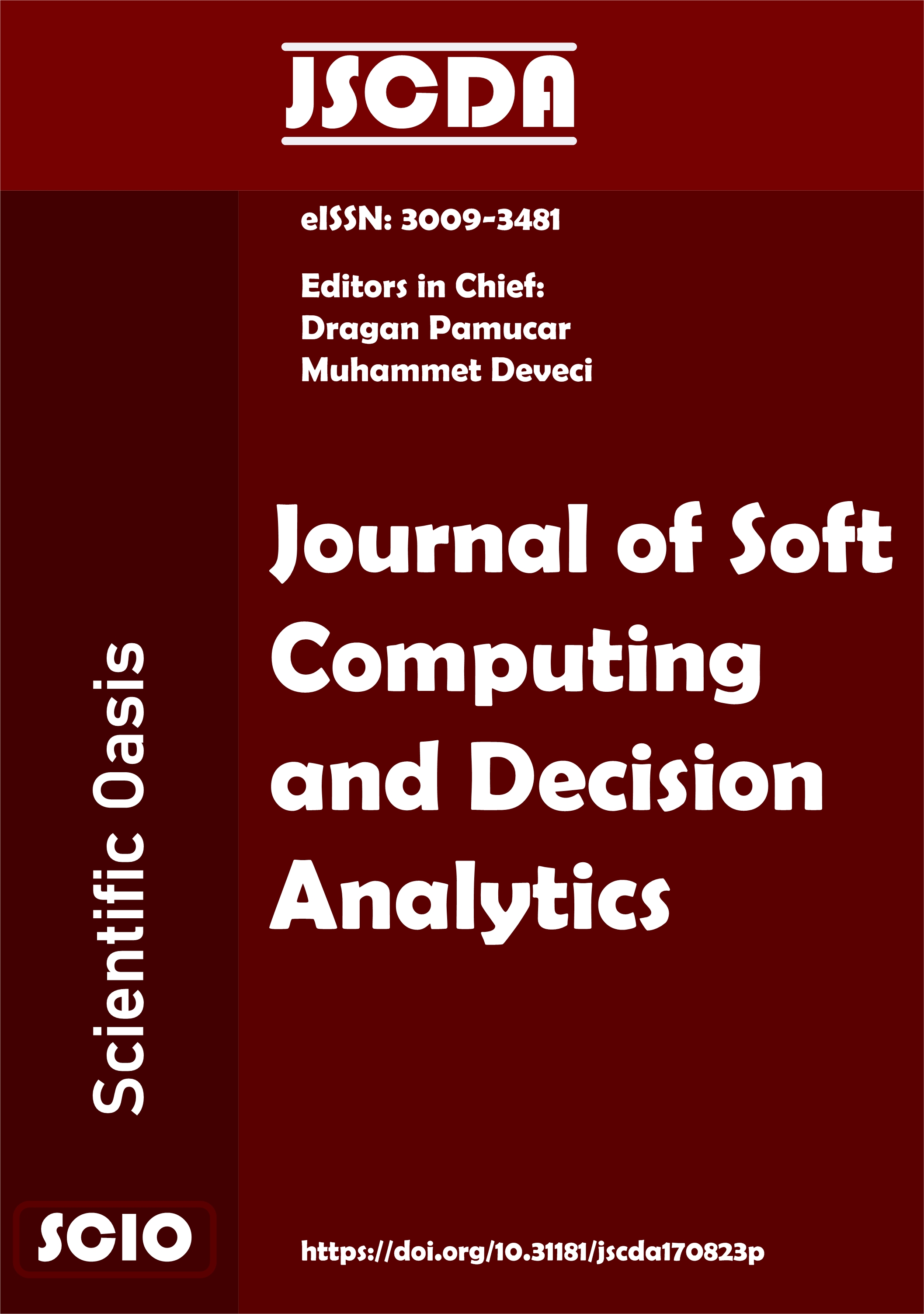Priority Strategy Development with Intuitionistic Fuzzy DEMATEL Method for Reducing Energy Costs in Hospitals
DOI:
https://doi.org/10.31181/jscda31202548Keywords:
Hospital, Health management, Energy, Renewable energy, Fuzzy DEMATELAbstract
Sustainable health service delivery plays a vital role for the development of countries. Sustainability of health services is associated with many factors. One of these factors is energy costs. Hospitals are buildings with high energy consumption. Accordingly, it is important to reduce energy costs in hospitals. For this purpose, it is necessary to determine the factors affecting the costs. In this way, improvements can be made without incurring very high costs. However, there are limited studies on determining the factors affecting energy costs in hospitals. Therefore, the aim of this study is to identify the important factors affecting energy costs in hospitals. In this context, the research question of the study is to determine which strategies will be implemented to reduce energy costs in hospitals. As a result of the literature review, the criteria affecting these costs are determined. The identified criteria are weighted by intuitionistic fuzzy DEMATEL method. The analysis results show that the most appropriate strategy is to reduce energy dependency with renewable energy alternatives (w=0,143). The criterion of reducing energy costs through government incentives also has an important place (w=0,136). The least influential factor is distributing informative documents on energy saving to patients/caregivers (w=0,9). Therefore, to manage energy costs in hospitals, it is appropriate to turn to renewable energy alternatives. Furthermore, government incentives such as tax exemptions are an important strategy. Establishing a good monitoring mechanism by the management would be appropriate to reduce costs.
References
Haakenstad, A., Irvine, C. M. S., Knight, M., Bintz, C., Aravkin, A. Y., Zheng, P., & Sahu, M. (2022). Measuring the availability of human resources for health and its relationship to universal health coverage for 204 countries and territories from 1990 to 2019: a systematic analysis for the Global Burden of Disease Study 2019. The Lancet, 399(10341), 2129-2154. https://doi.org/10.1016/S0140-6736(22)00532-3
Van den Berg, M., Van Beuningen, F. E., Ter Maaten, J. C., & Bouma, H. R. (2022). Hospital-related costs of sepsis around the world: A systematic review exploring the economic burden of sepsis. Journal of Critical Care, 71, 154096. https://doi.org/10.1016/j.jcrc.2022.154096
Demir Uslu, Y., Gökalp, Y., Yüksel, S., ETİ, S., & DİNÇER, H. (2024). Defining Effective Performance Management Strategies for Hospital with a Novel Fuzzy Decision-Making Model. Bezmialem Science, 12(1). https://doi.org/10.14235/bas.galenos.2023.23245
Eti, S., Dinçer, H., Yüksel, S., & Gökalp, Y. (2023). Analysis of the suitability of the solar panels for hospitals: A new fuzzy decision-making model proposal with the T-spherical TOP-DEMATEL method. Journal of Intelligent & Fuzzy Systems, 44(3), 4613-4625. https://doi.org/10.3233/JIFS-222968
Zhao, H. X., & Magoulès, F. (2012). A review on the prediction of building energy consumption. Renewable and Sustainable Energy Reviews, 16(6), 3586-3592. https://doi.org/10.1016/j.rser.2012.02.049
Lai, J. H., Hou, H. C., Chiu, B. W., Edwards, D., Yuen, P. L., Sing, M., & Wong, P. (2022). Importance of hospital facilities management performance indicators: Building practitioners’ perspectives. Journal of Building Engineering, 45, 103428. https://doi.org/10.1016/j.jobe.2021.103428
Jing, R., Wang, M., Brandon, N., & Zhao, Y. (2017). Multi-criteria evaluation of solid oxide fuel cell based combined cooling heating and power (SOFC-CCHP) applications for public buildings in China. Energy, 141, 273-289. https://doi.org/10.1016/j.energy.2017.08.111
Novikova, A., Szalay, Z., Horváth, M., Becker, J., Simaku, G., & Csoknyai, T. (2020). Assessment of energy-saving potential, associated costs and co-benefits of public buildings in Albania. Energy Efficiency, 13, 1387-1407. https://doi.org/10.1007/s12053-020-09883-3
Rastegarpour, S., Ghaemi, M., & Ferrarini, L. (2018, March). A predictive control strategy for energy management in buildings with radiant floors and thermal storage. In 2018 SICE International Symposium on Control Systems (SICE ISCS) (pp. 67-73). IEEE. https://doi.org/10.23919/SICEISCS.2018.8330158
Alirahmi, S. M., Assareh, E., Pourghassab, N. N., Delpisheh, M., Barelli, L., & Baldinelli, A. (2022). Green hydrogen & electricity production via geothermal-driven multi-generation system: Thermodynamic modeling and optimization. Fuel, 308, 122049. https://doi.org/10.1016/j.fuel.2021.122049
Billanes, J., & Enevoldsen, P. (2021). A critical analysis of ten influential factors to energy technology acceptance and adoption. Energy Reports, 7, 6899-6907. https://doi.org/10.1016/j.egyr.2021.09.118
Abd Rahman, N. M., Lim, C. H., & Fazlizan, A. (2021). Optimizing the energy saving potential of public hospital through a systematic approach for green building certification in Malaysia. Journal of Building Engineering, 43, 103088. https://doi.org/10.1016/j.jobe.2021.103088
Gökalp, Y., Yüksel, S., & Dinçer, H. (2022). Balanced scorecard-based cost analysis of service industry using a novel hybrid decision making approach based on golden cut-oriented bipolar and q-ROF sets. Journal of Intelligent & Fuzzy Systems, 43(4), 4709-4722. https://doi.org/10.3233/JIFS-220126
Rogers, D. (2018). Building management 4.0: Smart technology and the great American retrofit. Construction Research and Innovation, 9(1), 21-25. https://doi.org/10.1080/20450249.2018.1440969
Dinçer, H., Eti, S., Gökalp, Y., Yüksel, S., & Çelebi, B. (2023). The role of small-scale wind turbines in increasing the competitiveness of hospitals. In Handbook of research on quality and competitiveness in the healthcare services sector (pp. 336-352). IGI Global.
Kiliç, G., Al, K., Dağtekin, E., & Ünver, Ü. (2020). Technical, economic and environmental investigation of grid-independent hybrid energy systems applicability: a case study. Energy Sources, Part A: Recovery, Utilization, and Environmental Effects, 1-16. https://doi.org/10.1080/15567036.2020.1825565
Jahangir, M. H., Eslamnezhad, S., Mousavi, S. A., & Askari, M. (2021). Multi-year sensitivity evaluation to supply prime and deferrable loads for hospital application using hybrid renewable energy systems. Journal of Building Engineering, 40, 102733. https://doi.org/10.1016/j.jobe.2021.102733
Munday, J., Delaforce, A., Heidke, P., Rademakers, S., Sturgess, D., Williams, J., & Douglas, C. (2023). Perioperative temperature monitoring for patient safety: A period prevalence study of five hospitals. International Journal of Nursing Studies, 143, 104508. https://doi.org/10.1016/j.ijnurstu.2023.104508
Moorthi, M., Merisha, R., NithyaRachel, A., & Rajalakshmi, K. (2023, July). A Medicare System for Monitoring And Nerve Stimulation of Immobilized Patients. In 2023 4th International Conference on Electronics and Sustainable Communication Systems (ICESC) (pp. 1340-1345). IEEE. https://doi.org/10.1109/ICESC57686.2023.10193704
Isazadeh, A., Kamal, R., Yagua, C., Eluvathingal, S., & Claridge, D. E. (2021). Detecting deficiencies using building performance data in healthcare facilities: Improving operational efficiency with Continuous Commissioning®. Energy and Buildings, 241, 110953. https://doi.org/10.1016/j.enbuild.2021.110953
Zaroni, H., Maciel, L. B., Carvalho, D. B., & Pamplona, E. D. O. (2019). Monte Carlo Simulation approach for economic risk analysis of an emergency energy generation system. Energy, 172, 498-508. https://doi.org/10.1016/j.energy.2019.01.145
Bawaneh, K., Ghazi Nezami, F., Rasheduzzaman, M., & Deken, B. (2019). Energy consumption analysis and characterization of healthcare facilities in the United States. Energies, 12(19), 3775. https://doi.org/10.3390/en12193775
Abdullah, L., Zulkifli, N., Liao, H., Herrera-Viedma, E., & Al-Barakati, A. (2019). An interval-valued intuitionistic fuzzy DEMATEL method combined with Choquet integral for sustainable solid waste management. Engineering Applications of Artificial Intelligence, 82, 207-215. https://doi.org/10.1016/j.engappai.2019.04.005
Ocampo, L., & Yamagishi, K. (2020). Modeling the lockdown relaxation protocols of the Philippine government in response to the COVID-19 pandemic: An intuitionistic fuzzy DEMATEL analysis. Socio-economic planning sciences, 72, 100911. https://doi.org/10.1016/j.seps.2020.100911
Abdullah, L., Pouzi, H. M., & Awang, N. A. (2023). Intuitionistic fuzzy DEMATEL for developing causal relationship of water security. International Journal of Intelligent Computing and Cybernetics, 16(3), 520-544. https://doi.org/10.1108/IJICC-11-2022-0296
Choudhary, S., Panda, T. K., & Behl, A. (2023). Modelling the interrelationships of critical success factors of humanitarian supply chain: an intuitionistic fuzzy DEMATEL approach. Benchmarking: An International Journal. https://doi.org/10.1108/BIJ-02-2023-0080
Downloads
Published
Issue
Section
License
Copyright (c) 2025 Scientific Oasis

This work is licensed under a Creative Commons Attribution-NonCommercial-NoDerivatives 4.0 International License.
















